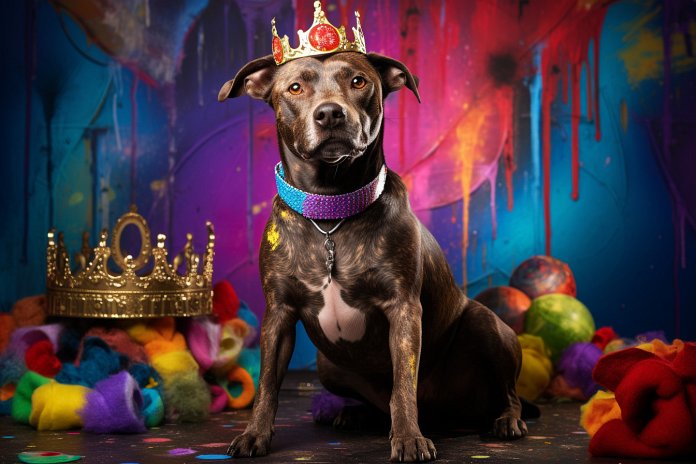
Is your Bulldog behaving like the boss of the family, even bullying other dogs? This can be a funny cartoon scenario, but in reality, some dogs can be dominant and not just towards other dogs, but towards their human family as well. Dominance can be a problem that leads to fear and aggression in dogs, causing issues at the dog park and making people hesitant to enter your home. Dogs are capable of feeling dominance and can disrupt harmony with their bad behavior.
Signs a Dog is Dominant
Having a dominant dog can be a nightmare, forcing you to avoid areas with people and other dogs. You may be banned from the local dog park and feel like an outcast in your own neighborhood. For example, your shelter dog Rexy may be asserting his dominance over everyone in the family, especially targeting Misa, your daughter’s toy poodle. Rexy’s behavior includes scaring neighbors at the front door, making Misa fearful and causing her to have accidents. Rexy also exhibits aggressive behavior towards the cat, establishing dominance over other animals.
Some dominant dogs will even prevent people from entering their territory, barking and biting at anyone who tries to pass through the gate. Dogs like Rexy may be super-territorial due to their past experiences of being chained up and isolated. They now guard their property, family, and food with aggression.
Understanding Dog Dominance
Dogs share a lot of DNA with wolves, but they have been bred by humans into hundreds of different breeds over thousands of years. While some trainers believe dogs inherit dominance from their wolf ancestors, others argue that wolves in the wild live as families rather than packs with an alpha male and female. Dogs have evolved to be friendlier and more interested in humans as companions.
Dominance in dogs can be a result of past abuse or mistreatment by humans. Guard dogs, for example, may appear dominant but they are typically trained to react appropriately. Dominance in dogs is learned from events and experiences, and using forceful training methods to alter dominance behaviors can be counterproductive and even make a dog more aggressive.
Positive Training for Dominant Dogs
Positive reinforcement training, as advocated by trainer Victoria Stilwell, is a more humane approach to dealing with dominant dogs. Dogs should never be punished for their dominance behavior. Dogs do not enter a home with the intention of taking control; they already recognize that humans have a certain degree of leadership. Breaking a dog’s spirit only creates a submissive and unfulfilled pet. Dogs have incredible abilities and can be trained using positive methods that allow them to reach their full potential and trust humans.
If your dog is exhibiting dominant behavior, it is important to understand the underlying cause and seek professional help. Training should focus on positive reinforcement and teaching basic obedience commands. Punishment should be avoided, and instead, bad behavior should result in the withholding of rewards and attention. It is time to leave punishment behind and have fun training our dogs to be sociable, happy, and valued members of the family.
Safety Tips for Dealing with Dominant Dogs
– Seek advice from a professional dog trainer
– Read articles on changing the behavior of dominant dogs
– Ensure the safety of people in the home
– Consult with your vet for advice
– Keep dominant dogs away from children
– Keep them on a leash in the dog park
– Avoid physically or emotionally punishing the dog
– Be aware that they could potentially bite someone.
“Positive training techniques are the key to transforming dominant dogs into happy, well-behaved companions.”

Tips & Things to Know
1️⃣ Seek professional help: If you have a dog that displays dominating behavior, it’s important to seek advice from a professional dog trainer who can provide guidance and techniques to address the issue effectively.
2️⃣ Use positive reinforcement: Punishing a dog for dominant behavior can be counterproductive and may worsen the problem. Instead, focus on positive training techniques that reward good behavior and encourage positive interactions.
3️⃣ Ensure safety: It’s crucial to prioritize safety when dealing with a dominating dog. This includes keeping people in the home safe, keeping the dog away from children, and taking precautions when visiting public places like the dog park. Always be aware that a dominating dog may have the potential to bite, so it’s important to take necessary precautions to prevent any harm.
Frequently Asked Questions, Answered ✅
1. What are the signs that a dog is dominant?
– Growling, barking, guarding, howling, biting, ears back, exposed teeth are all signs that a dog may have dominance issues.
2. Can a dog’s dominance be attributed to its breed?
– No, a dominant dog can come in all shapes and sizes, and their behavior is often a result of their past experiences and treatment.
3. How should dominant dogs be trained?
– Positive reinforcement and reward-based training methods are recommended for dominant dogs, as harsh punishment can worsen their behavior.
4. Is it possible for a dominant dog to be rehabilitated?
– With intervention and proper training, it is possible for a dominant dog to change their behavior and become a sociable and valued member of the family.
5. What safety precautions should be taken with dominant dogs?
– Seeking advice from a professional dog trainer, reading articles on behavior modification, keeping people in the home safe, consulting with a vet, keeping them away from children, not letting them off-leash in the dog park, and avoiding physical or emotional punishment are important safety tips to consider when dealing with a dominant dog.